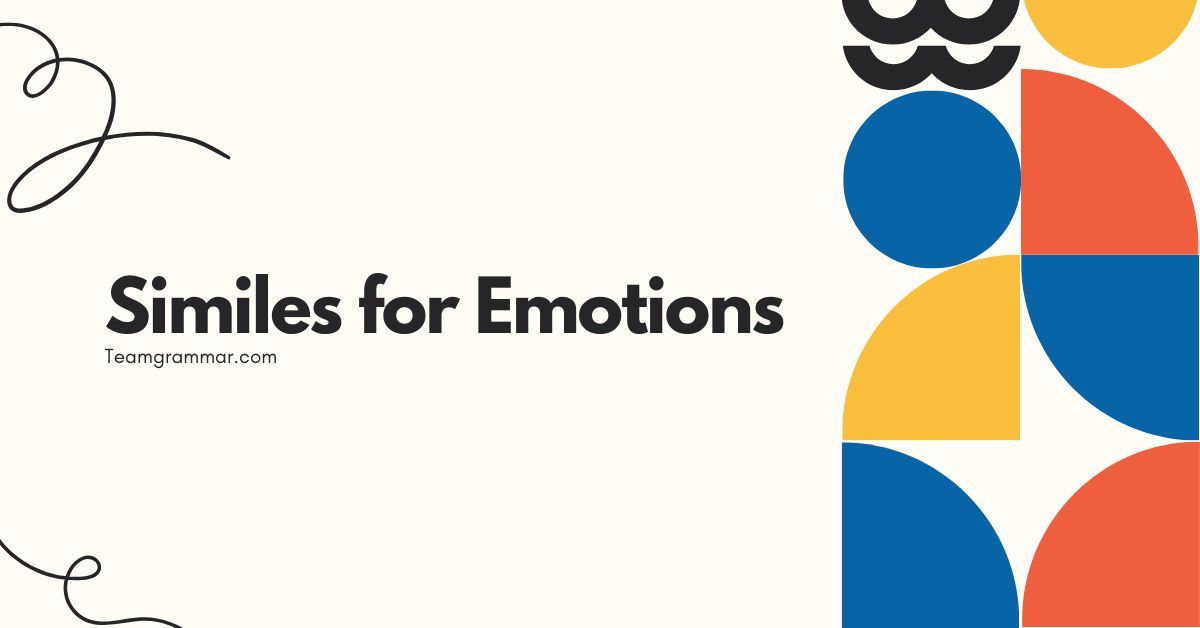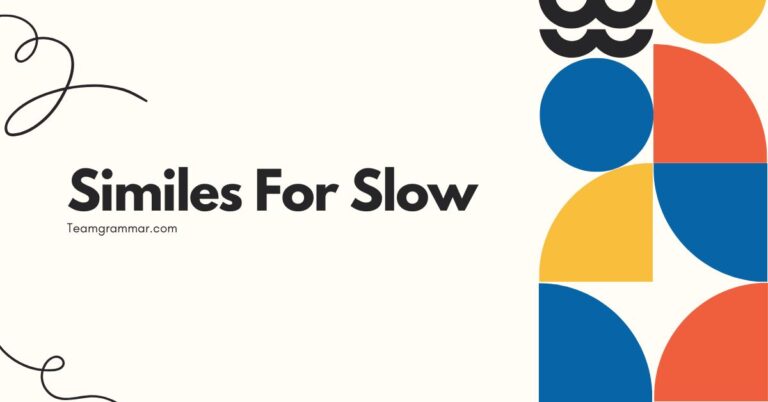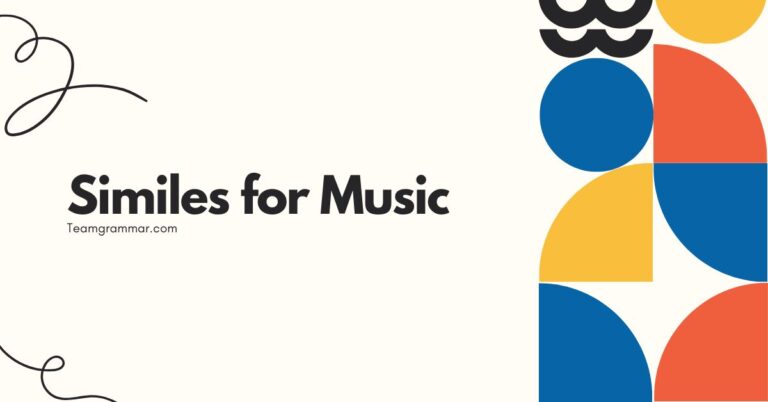31 Similes for Emotions: Mastering Figurative Language
Understanding and using similes effectively can significantly enhance your ability to express emotions in writing and speech. Similes provide a vivid and relatable way to describe feelings by comparing them to something familiar.
This article delves into the world of similes, specifically focusing on their application in conveying a wide range of emotions. Whether you’re a student, a writer, or simply someone looking to improve their communication skills, this comprehensive guide will equip you with the knowledge and tools to master the art of using similes to express emotions.
This guide is beneficial for anyone looking to expand their vocabulary, improve their writing skills, or gain a deeper understanding of how language can be used to express complex emotional states. By exploring various types of similes, understanding their structure, and practicing their usage, you’ll be able to communicate your feelings and ideas with greater clarity and impact.
Table of Contents
- Definition of Similes for Emotions
- Structural Breakdown of Similes
- Types and Categories of Similes for Emotions
- Examples of Similes for Emotions
- Usage Rules for Similes
- Common Mistakes When Using Similes
- Practice Exercises
- Advanced Topics in Similes
- Frequently Asked Questions
- Conclusion
Definition of Similes for Emotions
A simile is a figure of speech that compares two unlike things using the words “like” or “as.” Its primary function is to create a vivid image or enhance understanding by drawing a parallel between something familiar and something less known. When used to describe emotions, similes help to express the intensity, nuance, and complexity of feelings in a way that resonates with the audience.
In the context of emotional expression, similes serve to make abstract feelings more concrete and relatable. For example, instead of simply saying someone is “angry,” you might say they are “as angry as a hornet,” which provides a more intense and specific image of their anger.
Similes are classified as a type of figurative language, specifically a type of comparison. They belong to the broader category of tropes, which involve using words or phrases in a non-literal sense.
The function of a simile is primarily descriptive and explanatory, helping to clarify and amplify the emotional state being conveyed.
Function of Similes
The primary function of similes is to create a vivid and relatable comparison between two distinct things, using words such as “like” or “as.” In the context of emotions, similes help translate abstract feelings into concrete images, making them more accessible and impactful to the listener or reader. They enhance understanding by drawing parallels between the emotional state and something familiar, thus amplifying the emotional effect.
Classification of Similes
Similes fall under the broader category of figurative language, specifically comparisons. They are a type of trope, where words are used in a non-literal sense to achieve a particular effect.
Similes can be further classified based on the type of comparison they make, such as comparing emotions to natural phenomena, animals, objects, or abstract concepts. This classification helps in choosing the most effective simile to convey a specific emotion.
Contexts of Similes
Similes are versatile and can be used in various contexts, including literature, poetry, everyday conversation, and formal writing. The choice of simile depends on the audience, the purpose of the communication, and the desired tone.
In creative writing, similes add depth and imagery, while in everyday conversation, they can make expressions more engaging and relatable. Understanding the context is crucial for selecting and using similes effectively.
Structural Breakdown of Similes
The basic structure of a simile involves three key components: the subject (the emotion being described), the linking word (“like” or “as”), and the object (the thing the emotion is being compared to). Understanding this structure is essential for creating effective and clear similes.
The structure of a simile can be represented as follows:
Subject + Linking Word + Object
For example, in the simile “He was as brave as a lion,” “He” is the subject, “as” is the linking word, and “a lion” is the object. This structure provides a framework for creating similes that are both grammatically correct and effective in conveying the intended meaning.
Subject
The subject is the emotion or the person experiencing the emotion that you are describing. It’s the focus of the simile and the element that you want to make more vivid or understandable.
Linking Word
The linking word is either “like” or “as.” It connects the subject to the object, indicating that a comparison is being made. The choice between “like” and “as” is often a matter of personal preference or stylistic choice, although “as” is generally used in more formal contexts.
Object
The object is the thing to which the emotion is being compared. It should be something familiar or easily understood, so that the comparison helps to clarify and amplify the emotion being described.
The object provides a concrete image that the audience can relate to.
Types and Categories of Similes for Emotions
Similes for emotions can be categorized based on the type of object they use for comparison. Common categories include similes that compare emotions to natural phenomena, animals, objects, and abstract concepts.
Each category offers a unique way to express emotions and can be used to create different effects.
Similes Comparing Emotions to Nature
These similes use elements of nature, such as weather, landscapes, or natural events, to describe emotions. They can be particularly effective in conveying the intensity and unpredictability of feelings.
Similes Comparing Emotions to Animals
These similes draw on the characteristics and behaviors of animals to describe emotions. They can be used to highlight specific qualities associated with the emotion, such as strength, fear, or happiness.
Similes Comparing Emotions to Objects
These similes use inanimate objects to describe emotions. They can be effective in conveying the state of being, such as stability, fragility, or tension.
Similes Comparing Emotions to Abstract Concepts
These similes compare emotions to abstract ideas or concepts, such as time, color, or music. They can be used to convey more complex and nuanced feelings.
Examples of Similes for Emotions
Understanding how to use similes effectively requires seeing them in action. The following tables provide numerous examples of similes used to describe various emotions, categorized by the type of object they use for comparison.
The table below showcases similes using natural phenomena to describe various emotions. Each example provides a vivid comparison that helps to illustrate the intensity and characteristics of the emotion.
| Emotion | Simile |
|---|---|
| Anger | He was as angry as a thunderstorm. |
| Sadness | She felt as sad as a rainy day. |
| Joy | They were as joyful as a sunny morning. |
| Fear | He was as fearful as a leaf in a hurricane. |
| Calmness | She felt as calm as a still lake. |
| Anxiety | He was as anxious as a storm brewing on the horizon. |
| Excitement | She felt as excited as fireworks on the Fourth of July. |
| Despair | He was as despairing as a desert without water. |
| Hope | She felt as hopeful as the first sign of spring. |
| Loneliness | He was as lonely as a cloud floating alone in the sky. |
| Love | Their love was as warm as the summer sun. |
| Guilt | He felt as guilty as a shadow in the bright sunlight. |
| Regret | She was as full of regret as a barren field after harvest. |
| Frustration | He felt as frustrated as a river blocked by a dam. |
| Disappointment | She was as disappointed as a wilting flower. |
| Relief | He felt as relieved as the air after a heavy rain. |
| Surprise | She was as surprised as a sudden earthquake. |
| Confusion | He was as confused as a dense fog. |
| Contentment | She felt as content as a peaceful meadow. |
| Envy | He was as envious as a parched land watching the rain fall elsewhere. |
| Nostalgia | She felt as nostalgic as an old photograph fading with time. |
| Awe | He was as awestruck as a mountain climber viewing a vast landscape. |
| Indifference | She was as indifferent as a stone untouched by time. |
The following table provides examples of similes that use animals to describe different emotional states. These comparisons leverage the inherent characteristics of animals to amplify and illustrate the emotions.
| Emotion | Simile |
|---|---|
| Anger | He was as angry as a caged tiger. |
| Sadness | She felt as sad as a lost puppy. |
| Joy | They were as joyful as playful dolphins. |
| Fear | He was as fearful as a mouse in a snake’s path. |
| Calmness | She felt as calm as a purring cat. |
| Anxiety | He was as anxious as a hummingbird in a storm. |
| Excitement | She felt as excited as a puppy with a new toy. |
| Despair | He was as despairing as a bird with a broken wing. |
| Hope | She felt as hopeful as a robin in spring. |
| Loneliness | He was as lonely as a wolf howling at the moon. |
| Love | Their love was as loyal as a dog’s. |
| Guilt | He felt as guilty as a fox caught stealing. |
| Regret | She was as full of regret as a snail leaving a trail. |
| Frustration | He felt as frustrated as a bear stuck in a trap. |
| Disappointment | She was as disappointed as a fish out of water. |
| Relief | He felt as relieved as a bird escaping a cage. |
| Surprise | She was as surprised as a cat seeing a cucumber. |
| Confusion | He was as confused as a chameleon in a bag of Skittles. |
| Contentment | She felt as content as a cow grazing in a field. |
| Envy | He was as envious as a peacock seeing another’s display. |
| Nostalgia | She felt as nostalgic as a moth drawn to an old flame. |
| Awe | He was as awestruck as an owl watching a meteor shower. |
| Indifference | She was as indifferent as a snake shedding its skin. |
This table illustrates similes that use everyday objects to describe emotions. These comparisons make the emotions more relatable and understandable by associating them with familiar items.
| Emotion | Simile |
|---|---|
| Anger | He was as angry as a pressure cooker about to explode. |
| Sadness | She felt as sad as a broken vase. |
| Joy | They were as joyful as a ringing bell. |
| Fear | He was as fearful as a house of cards in the wind. |
| Calmness | She felt as calm as a still pond. |
| Anxiety | He was as anxious as a ticking bomb. |
| Excitement | She felt as excited as a jack-in-the-box. |
| Despair | He was as despairing as a deflated balloon. |
| Hope | She felt as hopeful as a lit candle in the dark. |
| Loneliness | He was as lonely as an empty room. |
| Love | Their love was as strong as a steel cable. |
| Guilt | He felt as guilty as a stain that won’t come out. |
| Regret | She was as full of regret as a rusty key that no longer opens any door. |
| Frustration | He felt as frustrated as a tangled ball of yarn. |
| Disappointment | She was as disappointed as a broken toy. |
| Relief | He felt as relieved as a weight lifted off his shoulders. |
| Surprise | She was as surprised as finding a diamond in the rough. |
| Confusion | He was as confused as a jigsaw puzzle with missing pieces. |
| Contentment | She felt as content as a warm blanket on a cold day. |
| Envy | He was as envious as a beggar looking through a palace window. |
| Nostalgia | She felt as nostalgic as a worn photograph album. |
| Awe | He was as awestruck as a child seeing a magic trick. |
| Indifference | She was as indifferent as a stone on a road. |
The following table demonstrates similes that compare emotions to abstract concepts, offering a deeper and more nuanced understanding of the emotional states.
| Emotion | Simile |
|---|---|
| Anger | He was as angry as a burning fire. |
| Sadness | She felt as sad as a silent song. |
| Joy | They were as joyful as a lively dance. |
| Fear | He was as fearful as a shadow in the night. |
| Calmness | She felt as calm as a quiet meditation. |
| Anxiety | He was as anxious as a dissonant chord. |
| Excitement | She felt as excited as a crescendo in music. |
| Despair | He was as despairing as a void without end. |
| Hope | She felt as hopeful as a new beginning. |
| Loneliness | He was as lonely as an echo in a canyon. |
| Love | Their love was as infinite as the universe. |
| Guilt | He felt as guilty as a lie uncovered. |
| Regret | She was as full of regret as a missed opportunity. |
| Frustration | He felt as frustrated as an unsolved puzzle. |
| Disappointment | She was as disappointed as a dream unfulfilled. |
| Relief | He felt as relieved as a burden lifted. |
| Surprise | She was as surprised as a sudden revelation. |
| Confusion | He was as confused as a maze without an exit. |
| Contentment | She felt as content as a peaceful resolution. |
| Envy | He was as envious as a wish ungranted. |
| Nostalgia | She felt as nostalgic as a cherished memory. |
| Awe | He was as awestruck as witnessing a miracle. |
| Indifference | She was as indifferent as a forgotten truth. |
Usage Rules for Similes
Using similes effectively involves adhering to certain rules to ensure clarity and impact. The most important rule is to ensure that the comparison is logical and relatable.
The object of the simile should be something that the audience is familiar with, and the comparison should highlight a specific quality or characteristic of the emotion being described.
1. Clarity:The comparison should be clear and easy to understand.
Avoid using obscure or overly complex objects.
2. Relevance:The object should be relevant to the emotion being described.
The comparison should highlight a specific quality or characteristic of the emotion.
3. Originality: While common similes can be effective, using original and creative comparisons can make your writing or speech more engaging and memorable.
4. Context:The choice of simile should be appropriate for the context.
Consider the audience, the purpose of the communication, and the desired tone.
Exceptions to Usage Rules
While the above rules provide a general framework for using similes, there are exceptions. In some cases, using a less familiar object can be effective if it creates a unique or unexpected comparison.
Additionally, breaking from conventional similes can add a creative flair to your writing. However, it’s important to ensure that the comparison still makes sense in the context and that the audience can understand the intended meaning.
Common Mistakes When Using Similes
One common mistake is using clichés or overused similes, which can make your writing sound unoriginal and predictable. Another mistake is creating comparisons that are illogical or unclear.
For example, saying “He was as angry as a spoon” doesn’t make sense because there’s no clear connection between anger and a spoon.
Incorrect: He was as angry as a spoon.
Correct: He was as angry as a boiling pot.
Another common error is using similes that contradict the intended meaning. For example, saying “She felt as happy as a funeral” is contradictory because funerals are associated with sadness, not happiness.
Incorrect: She felt as happy as a funeral.
Correct: She felt as happy as a wedding celebration.
Practice Exercises
Test your understanding of similes for emotions with the following exercises. Choose the best simile to complete each sentence, or create your own.
Exercise 1: Complete the following sentences with an appropriate simile.
| Question | Answer |
|---|---|
| 1. He was as nervous as ____ before his big presentation. | a cat on a hot tin roof |
| 2. She felt as peaceful as ____ after a long day. | a sleeping baby |
| 3. The children were as excited as ____ on Christmas morning. | bees around honey |
| 4. He was as stubborn as ____ when it came to his opinion. | a mule |
| 5. She felt as light as ____ after hearing the good news. | a feather |
| 6. The old house was as quiet as ____ in the dead of night. | a tomb |
| 7. He ran as fast as ____ to catch the bus. | the wind |
| 8. The soup was as hot as ____ straight from the stove. | lava |
| 9. Her smile was as bright as ____ on a summer day. | sunshine |
| 10. The problem was as clear as ____ after he explained it. | daylight |
Exercise 2: Create your own simile for each of the following emotions.
| Emotion | Your Simile |
|---|---|
| 1. Disgust | (Example: He felt as disgusted as if he had eaten rotten food.) |
| 2. Confidence | (Example: She was as confident as a lioness protecting her cubs.) |
| 3. Boredom | (Example: He was as bored as watching paint dry.) |
| 4. Empathy | (Example: She felt as empathetic as if she were walking in his shoes.) |
| 5. Irritation | (Example: He was as irritated as a mosquito bite.) |
| 6. Gratitude | (Example: She felt as grateful as a plant receiving water after a drought.) |
| 7. Vulnerability | (Example: He felt as vulnerable as a newborn baby.) |
| 8. Anticipation | (Example: She felt as much anticipation as a child waiting for Santa.) |
| 9. Resentment | (Example: He was as resentful as a prisoner in chains.) |
| 10. Optimism | (Example: She felt as optimistic as the first bloom of spring.) |
Advanced Topics in Similes
For advanced learners, exploring the use of extended similes and metaphorical similes can add depth and complexity to their writing. An extended simile is a simile that is developed over several sentences or paragraphs, allowing for a more detailed and nuanced comparison.
A metaphorical simile is a simile that uses a metaphor as its object, creating a double layer of figurative language.
Understanding the nuances of simile construction, especially how context and cultural background influence interpretation, is also essential. The effectiveness of a simile can vary depending on the audience’s familiarity with the object of comparison.
Therefore, advanced learners should be sensitive to these factors and choose similes that resonate with their intended audience.
Furthermore, exploring the history and evolution of similes in literature can provide valuable insights into their usage and impact. Studying the works of renowned authors who have mastered the art of using similes can inspire and inform your own writing.
Frequently Asked Questions
Q1: What is the difference between a simile and a metaphor?
A simile compares two things using “like” or “as,” while a metaphor directly states that one thing is another. For example, “He is as brave as a lion” is a simile, while “He is a lion” is a metaphor.
Q2: Can a simile be too obvious or cliché?
Yes, using overused similes can make your writing sound unoriginal. It’s best to aim for fresh and creative comparisons.
Q3: How do I choose the right object for a simile?
Choose an object that is familiar to your audience and that highlights a specific quality or characteristic of the emotion you’re describing. It should be relevant and logical.
Q4: Is it okay to use similes in formal writing?
Yes, but use them sparingly and choose similes that are appropriate for the tone and purpose of the writing. Avoid overly informal or colloquial comparisons.
Q5: Can I create my own similes?
Absolutely! Creating your own similes can make your writing more original and engaging.
Just make sure the comparison is clear and logical.
Q6: How can similes help me in everyday conversation?
Similes can make your expressions more vivid and relatable, helping you to communicate your feelings and ideas more effectively.
Q7: What are some common emotions that are often described using similes?
Common emotions include anger, sadness, joy, fear, calmness, anxiety, excitement, despair, hope, and loneliness. Each of these emotions can be effectively described using similes.
Q8: How do cultural differences affect the understanding of similes?
Cultural background can influence the interpretation of similes, as the familiarity and associations with certain objects may vary across cultures. Be mindful of your audience’s cultural background when choosing similes.
Q9: Can similes be used in poetry?
Yes, similes are commonly used in poetry to create vivid imagery and enhance the emotional impact of the poem.
Q10: What is an extended simile?
An extended simile is a simile that is developed over several sentences or paragraphs, allowing for a more detailed and nuanced comparison.
Conclusion
Mastering the use of similes for emotions can significantly enhance your ability to express feelings in a vivid and relatable way. By understanding the structure, types, and usage rules of similes, you can create comparisons that resonate with your audience and add depth to your writing and speech.
Remember to choose objects that are familiar and relevant, and to avoid clichés and illogical comparisons.
Practice is key to mastering any skill, so make sure to incorporate similes into your everyday communication and writing exercises. Experiment with different types of comparisons and explore the works of renowned authors to see how they use similes effectively.
With time and practice, you’ll be able to use similes to express emotions with greater clarity, impact, and creativity. Continue to explore and refine your understanding of similes, and you’ll find that they become a valuable tool in your communication arsenal.







